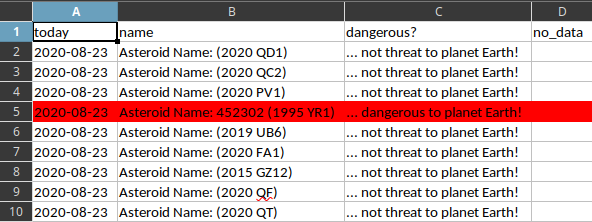This allows users to solve issues in the programming area, fast and easy.
I use python versiono 3.8.5 build on Aug 12 2020 at 00:00:00, see the result of interactive mode:
[mythcat@desk ~]$ python
Python 3.8.5 (default, Aug 12 2020, 00:00:00)
[GCC 10.2.1 20200723 (Red Hat 10.2.1-1)] on linux
Type "help", "copyright", "credits" or "license" for more information.Another tutorial about python and documents can be found here.
The openpyxl was created by Eric Gazoni, Charlie Clark, and is a Python library to read/write Excel 2010 xlsx/xlsm/xltx/xltm files.
Let's install the openpyxl python package:
[mythcat@desk ~]$ pip3 install openpyxl --user
Collecting openpyxl
...
Installing collected packages: openpyxl
Successfully installed openpyxl-3.0.5
from openpyxl import Workbook
wb = Workbook()
# grab the active worksheet
ws = wb.active
# Data can be assigned directly to cells
ws['A1'] = 42
# Rows can also be appended
ws.append([1, 2, 3])
# Python types will automatically be converted
import datetime
ws['A2'] = datetime.datetime.now()
# Save the file
wb.save("sample.xlsx")
The rows with dangerous asteroids are fill with the red color:
# check asteroids close to planet Earth and add it to file
# import json python package
import json, urllib.request, time
# import openpyxl python package
from openpyxl import Workbook
from openpyxl.styles import PatternFill
# use active worksheet
wb = Workbook()
ws = wb.active
today = time.strftime('%Y-%m-%d', time.gmtime())
print("Time is: " + today)
now = today
# retrieve data about asteroids approaching planet Earth into json format
url = "https://api.nasa.gov/neo/rest/v1/feed?start_date=" + today + "&end_date=" + today + "&api_key=DEMO_KEY"
response = urllib.request.urlopen(url)
result = json.loads(response.read())
print("Now, " + str(result["element_count"]) + " asteroids is close to planet Earth.")
asteroids = result["near_earth_objects"]
no_data = ""
dangerous = ""
ws.append(['today', 'name', 'dangerous?', 'no_data'])
# parsing all the JSON data and add to file
for asteroid in asteroids:
for field in asteroids[asteroid]:
try:
name = "Asteroid Name: " + field["name"]
if field["is_potentially_hazardous_asteroid"]:
dangerous = "... dangerous to planet Earth!"
else:
dangerous = "... not threat to planet Earth!"
except:
no_data = "no data"
ws.append([today, name, dangerous, no_data])
# create a red patern to fill
redFill = PatternFill(start_color='FFFF0000',
end_color='FFFF0000',
fill_type='solid')
# check the row with the dangerous asteroid and fill it
for row in ws.rows:
if row[2].value == "... dangerous to planet Earth!":
for cell in row:
cell.fill = redFill
# write all data to file
wb.save(str(now)+"_asteroids.xlsx")[mythcat@desk ~]$ python asteroid_data.py
Time is: 2020-08-23
Now, 9 asteroids is close to planet Earth.